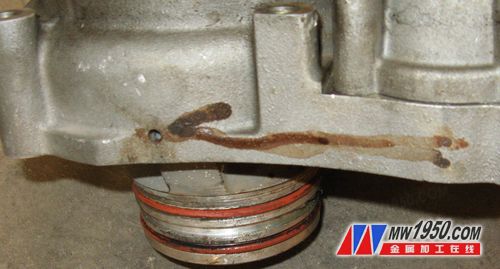Analysis of Causes of Cavitation in Pumps
The cavitation of the pump occurs generally in the pump impeller and the balance hole. It occurs in the pump body. The reason is that the gas content in the pump cooling circulation system is too high, the cavitation area is large and severe, and the relative hardness is low. Pump body (cast aluminum material) instead of impeller (cast iron material). Investigation of the cause of excessive gas content in the cooling system and easy cavitation of the pump casing material.
(1) Material detection and analysis The hardness of the pump body is HB83.5, and the chemical composition of the material ZL104 is as follows.
ingredient | Al | Si | Mn | Fe | Mg | Cu | Zn |
Sampling | the remaining | 10.43 | 0.24 | 0.14 | 0.11 | 0.01 | 0.027 |
standard value | the remaining | 8.0 ~ 10.5 | 0.2 to 0.5 | ≤0.9 | 0.17 ~ 0.35 | ≤0.1 | ≤0.25 |
The Mg content in the pump material is low. Generally, the Mg element has a solid-melting strengthening effect on the body. It is not excluded that the body structure is loose due to the sand casting of the pump body, and the cavitation of the water pump is accelerated due to the internal gas of the system.
(2) Coolant detection The quality of the coolant plays a vital role in the entire cooling cycle of the engine. If the coolant deteriorates, bubbles will be easily generated and the gas content in the system will be too high. For the detection of the PH value and boiling point of the coolant, the PH value is required to be 7.5 to 11.0, and the actual measurement is 8.8; the boiling point is required to be greater than 106 °C, and the measured value is 109 °C. Meet the requirements for use.
(3) Analysis of the pump structure The disassembled inspection of the faulty water pump reveals that the water seal of the pump water seal (or oil stain) is shown in Figure 1. The rust marks on the water seal installation of the pump shaft are shown in Figure 2, and the water seal is installed in the water pump body. The rust marks (or oil stains) are more serious. The gas discharge marks in the water discharge parts of the pump body are shown in Figure 3. The drain holes of the water pump body are shown in Figure 4 (communicating with the holes in Figure 3).

figure 1

figure 2

image 3

Figure 4
From the above situation comparison analysis: the leakage of the outside of the drain hole of the faulty water pump and the surface of the impeller of the pump body are cavitation, and there is no leakage on the outside of the drain hole of the intact pump and no cavitation on the surface of the impeller of the pump body. Therefore, it is determined that the water seal is not tight, which causes the water pump to leak in the axial direction during operation, causing the water pump shaft to rust, causing a large amount of gas to enter the pump body through the drain hole and rush into the pump chamber along the pump shaft and the water seal gap to the inside of the pump body. . From the working principle of the pump, the water flow is from the influent-outlet water, that is, if the leaked gas is directly brought into the water outlet by the impeller, the part with the largest pressure difference is the part where the impeller and the pump body fit together, and the bubble formed by the gas is first on the surface of the pump body. The rupture caused serious cavitation.
(4) Laboratory equipment inspection For the inspection of the engine test equipment, the sealing problem of the water inlet pipeline was not found, and there was no possibility of intake air. However, it was found that the engine circulating water line has no coolant retarding device, so many gases cannot be collected and discharged during the high-speed flow of the coolant. Moreover, it was found that the large circulating cooling system outside the laboratory was overloaded, resulting in a relatively high liquid temperature in the engine cooling system. From the use of the coolant, it is easier to vaporize under high temperature conditions, causing cavitation.
summary
Due to the poor sealing of the water seal of the pump, the serious cavitation of the pump occurs. Because the gas in the engine cooling water circulation pipeline cannot be collected and discharged, the high-temperature overload operation of the external circulation cooling system causes the gasification of the coolant to be intensified, so that the gas content in the pump is increased. Too high, causing serious cavitation of the pump.
Metal processing online more related information: metal processing online knowledge lecture: engine pump cavitation phenomenon
R-22, also called HCFC-22, has been a refrigerant mainstay for many years. This is suitable for a wide range of refrigeration and air conditioning applications across a wide range of temperatures. Therefore it became the most common refrigerant in many applications after the phase out of CFCs.
Zhejiang Zhonglan Refrigerants Co.,Ltd is a professional R22 refrigerants gas manufacture.
Chlorodifluoromethane R22 (need import license/permission)
HCFC-R22 Refrigerant Gas,R22 Refrigerant 30Lb,R22 Refrigerant Gas,R22 Refregerant
ZHEJIANG ZHONGLAN REFRIGERATION TECHNOLOGY CO.,LTD , http://www.uiszl.com